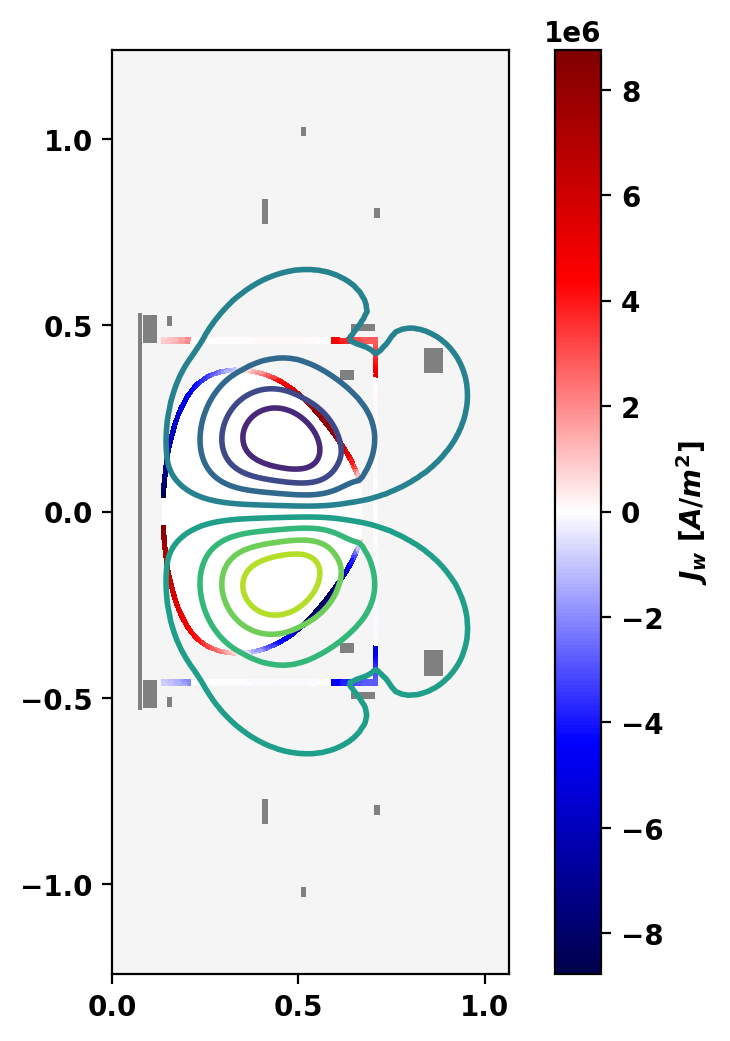In this example we show how toroidally non-continuous conductors can be used to model different conditions in LTX-β, including:
- Computing eddy currents during the OH pre-charge
- Solving for an two sequential "inverse" equilibria, with self-consistent eddy currents between them
- Computing vessel and plasma eigenmodes
This example utilizes the mesh built in TokaMaker Meshing Example: Building a mesh with toroidally non-continuous conductors for LTX.
- Warning
- Toroidally non-continuous conducting regions are still in development. Please be careful when using this feature and report any issues.
- Note
- Running this example requires the h5py python package, which is installable using
pipor other standard methods.
Load TokaMaker library
To load the TokaMaker python module we need to tell python where to the module is located. This can be done either through the PYTHONPATH environment variable or using within a script using sys.path.append() as below, where we look for the environement variable OFT_ROOTPATH to provide the path to where the OpenFUSIONToolkit is installed (/Applications/OFT on macOS).
For meshing we will use the gs_Domain() class to build a 2D triangular grid suitable for Grad-Shafranov equilibria. This class uses the triangle code through a python wrapper.
Setup solver
Initialize TokaMaker object
We now create a OFT_env instance for execution using two threads and a TokaMaker instance to use for equilibrium calculations. Note at present only a single TokaMaker instance can be used per python kernel, so this command should only be called once in a given Jupyter notebook or python script. In the future this restriction may be relaxed.
#---------------------------------------------- Open FUSION Toolkit Initialized Development branch: v1_beta6 Revision id: 681e857 Parallelization Info: # of MPI tasks = 1 # of NUMA nodes = 1 # of OpenMP threads = 2 Fortran input file = /var/folders/52/n5qxh27n4w19qxzqygz2btbw0000gn/T/oft_64730/oftpyin XML input file = none Integer Precisions = 4 8 Float Precisions = 4 8 16 Complex Precisions = 4 8 LA backend = native #----------------------------------------------
Load mesh into TokaMaker
Now we load the mesh generated in TokaMaker Meshing Example: Building a mesh with toroidally non-continuous conductors for LTX using load_gs_mesh() and setup_mesh(). Then we use setup_regions() to define the different region types. Finally, we call setup() to setup the required solver objects. During this call we can specify the desired element order (min=2, max=4) and the toroidal field through F0 = B0*R0, where B0 is the toroidal field at a reference location R0.
We also increase the maximum number of Picard iterations in the equilibrium solve to 80 from the default of 40.
**** Loading OFT surface mesh
**** Generating surface grid level 1
Generating boundary domain linkage
Mesh statistics:
Area = 2.640E+00
# of points = 3128
# of edges = 9241
# of cells = 6114
# of boundary points = 140
# of boundary edges = 140
# of boundary cells = 140
Resolution statistics:
hmin = 2.294E-03
hrms = 3.355E-02
hmax = 7.597E-02
Surface grounded at vertex 497
**** Creating Lagrange FE space
Order = 2
Minlev = -1
Computing flux BC matrix
Inverting real matrix
Time = 1.9570000000000000E-003
Define a vertical stability coil
Like many elongated equilibria, the equilibrium we seek to compute below is vertically unstable. In this case we use the "INTERNAL" coils in order to help with convergence using the set_coil_vsc() method, but in practice this stability is likely provided largely by the shell when plasma are sufficiently elongated.
Define hard limits on coil currents
Hard limits on coil currents can be set using set_coil_bounds(). In this case we just the simple and approximate bi-directional limit of 50 MA in each coil.
Bounds are specified using a dictionary of 2 element lists, containing the minimum and maximum bound, where the dictionary key corresponds to the coil names, which are available in mygs.coil_sets
Compute eddy currents during OH pre-charge
Here we demonstrate how to compute the evolution of vacuum fields in TokaMaker due to specified coil current waveforms and subject to eddy currents in conducting structures. For this example, we are using the "OH precharge", which is typical of most pulsed tokamaks, where the OH transformer is initially ramped to its maximum current (positive or negative) to allow the largest possible swing over the course of the shot ( \(\Delta I_{OH} \approx 2*I_{OH,max}\)). For this example we are ramping to the maximum current over 10 ms.
Compute Sequence of Vacuum Equilibria
To view the evolution of the magnetic field and eddy currents during this time we compute a series of vacuum equilibria using vac_solve() from t=0 to t=20 ms. At each time point we set the coil current in the OH coil according to the waveform above and use the last state as the reference \(\psi\) for set_psi_dt().
Plot Results
After computing the evolution of the flux we plot the motion of a given as it soaks through the conducting structures and into the bore of the OH. We also plot the eddy currents and \(\psi\) at t=10 ms to show an example distribution of eddy currents during the pre-charge.
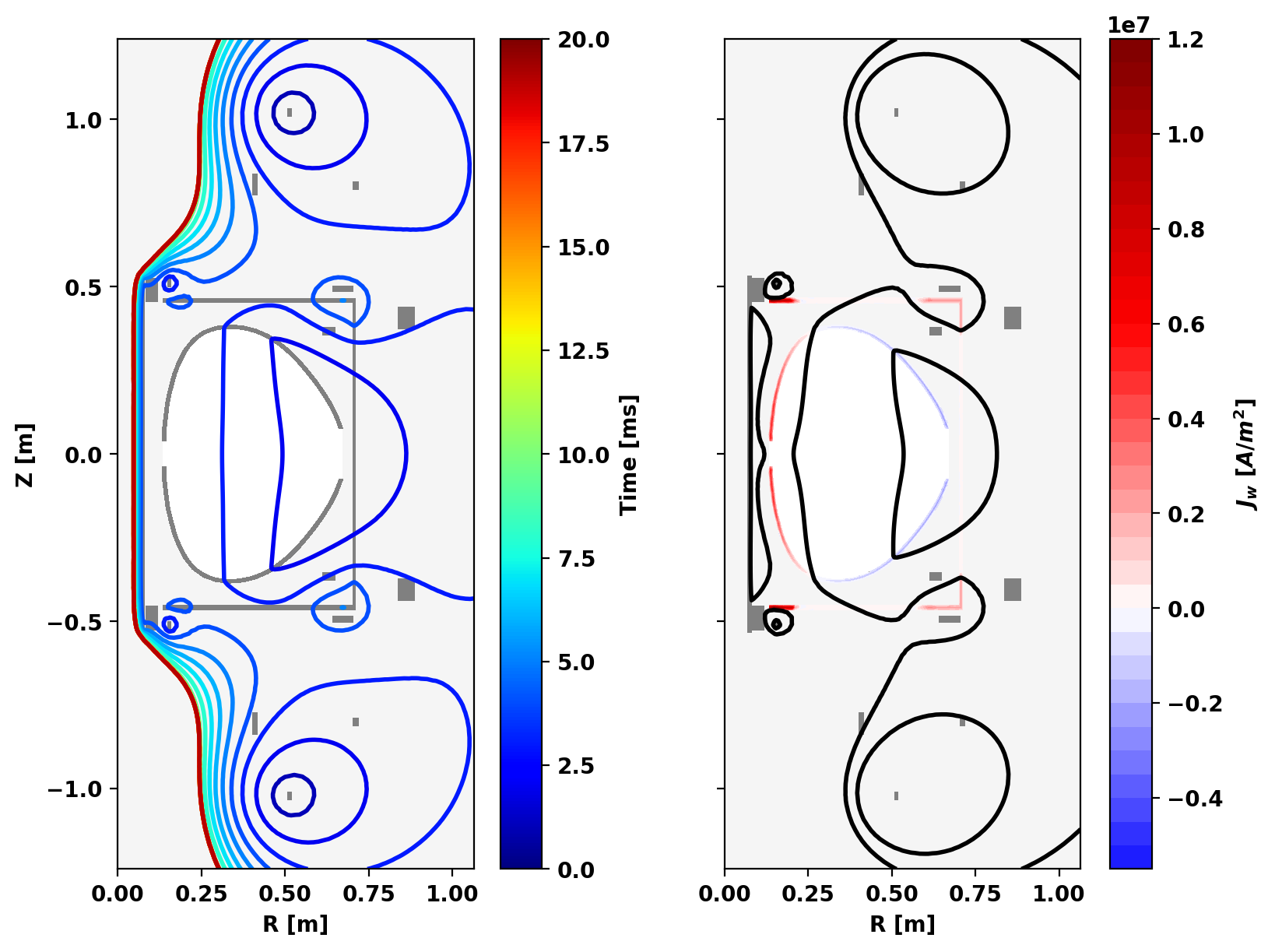
Compute Decay Modes of Conductor System
Here we compute the decay modes (L/R eigenvalues) of the conductors in our model.
Longest L/R time = 5.1203E-03 [s]
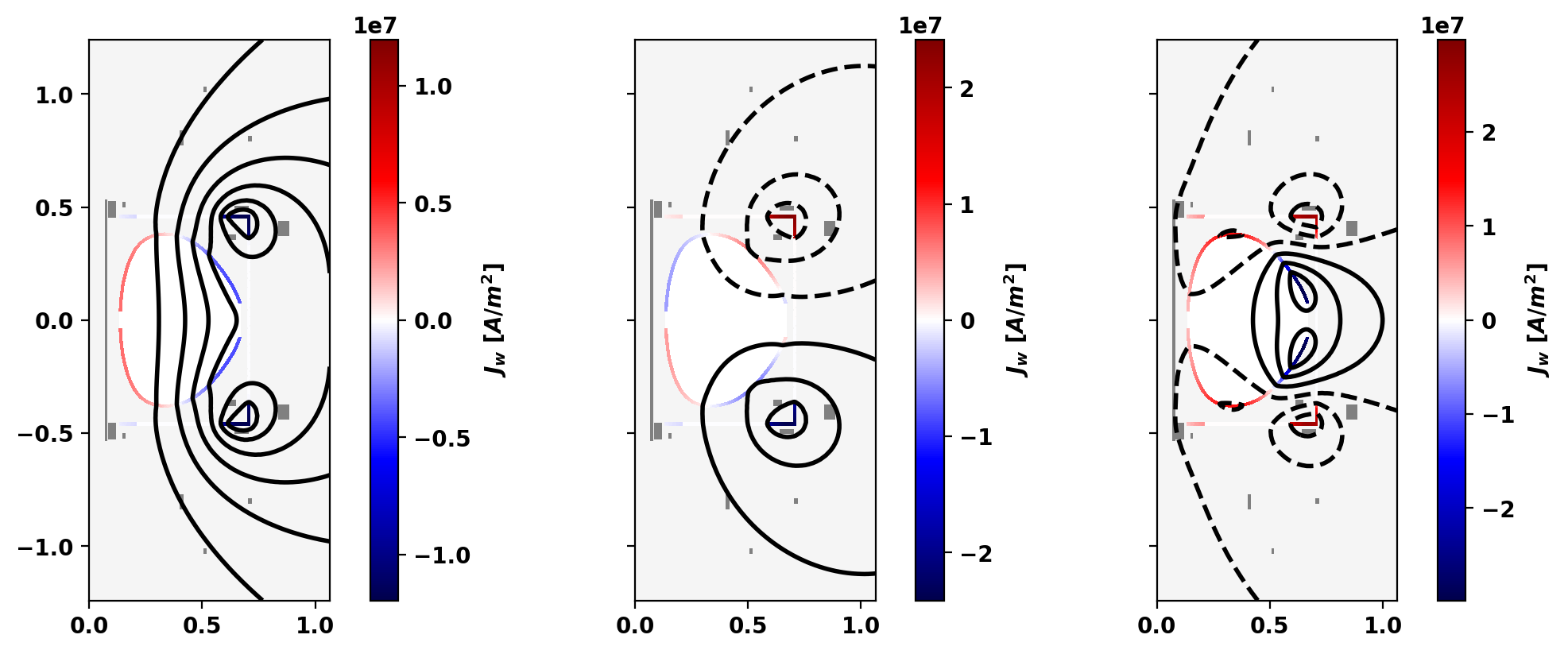
Compute flattop-like equilibrium
Define global quantities and targets
For the inverse case we define a target for the plasma current and the ratio the F*F' and P' contributions to the plasma current, which is approximately related to \(\beta_p\) as Ip_ratio = \(1/\beta_p - 1\).
- Note
- These constraints can be considered "hard" constraints, where they will be matched to good tolerance as long as the calculation converges.
Define shape targets
In order to constrain the shape of the plasma we can utilize isoflux points, which are points we want to lie on the same flux surface (eg. the LCFS).
- Note
- These constraints can be considered "soft" constraints, where the calculation attempts to minimize error in satisfying these constraints subject to other constraints and regularization.
Here we define a somewhat large number of isoflux points that we want to lie on a single surface of the target equilibrium.
Define coil regularization matrix
In general, for a given coil set a given plasma shape cannot be exactly reproduced, which generally yields large amplitude coil currents if no constraint on the coil currents is applied. As a result, it is useful to include regularization terms for the coils to balance minimization of the shape error with the amplitude of current in the coils. In TokaMaker these regularization terms have the general form, where each term corresponds to a set of coil coefficients, target value, and weight. The coil_reg_term() method is provided to aid in defining these terms.
Here we define two types of regularization targets:
- Targets that act to penalize up-down assymetry in U/L coil pairs
- Targets the act to penalize the amplitude of current in each coil
In the later case this regularization acts to penalize the amplitude of current in each coil, acting to balance coil current with error in the shape targets. Additionally, this target is also used to "disable" the YELLOW coil by setting the weight on its target high to strongly penalize non-zero current.
Define flux functions
Although TokaMaker has a "default" profile for the F*F' and P' terms this should almost never be used and one should instead choose an appropriate flux function for their application. In this case we use a simple cubic flux function, using create_spline_flux_fun(), with the same shape for both F*F' and P'. Within TokaMaker this profile is represented as a piecewise linear function, which can be set up using the dictionary approach shown below.
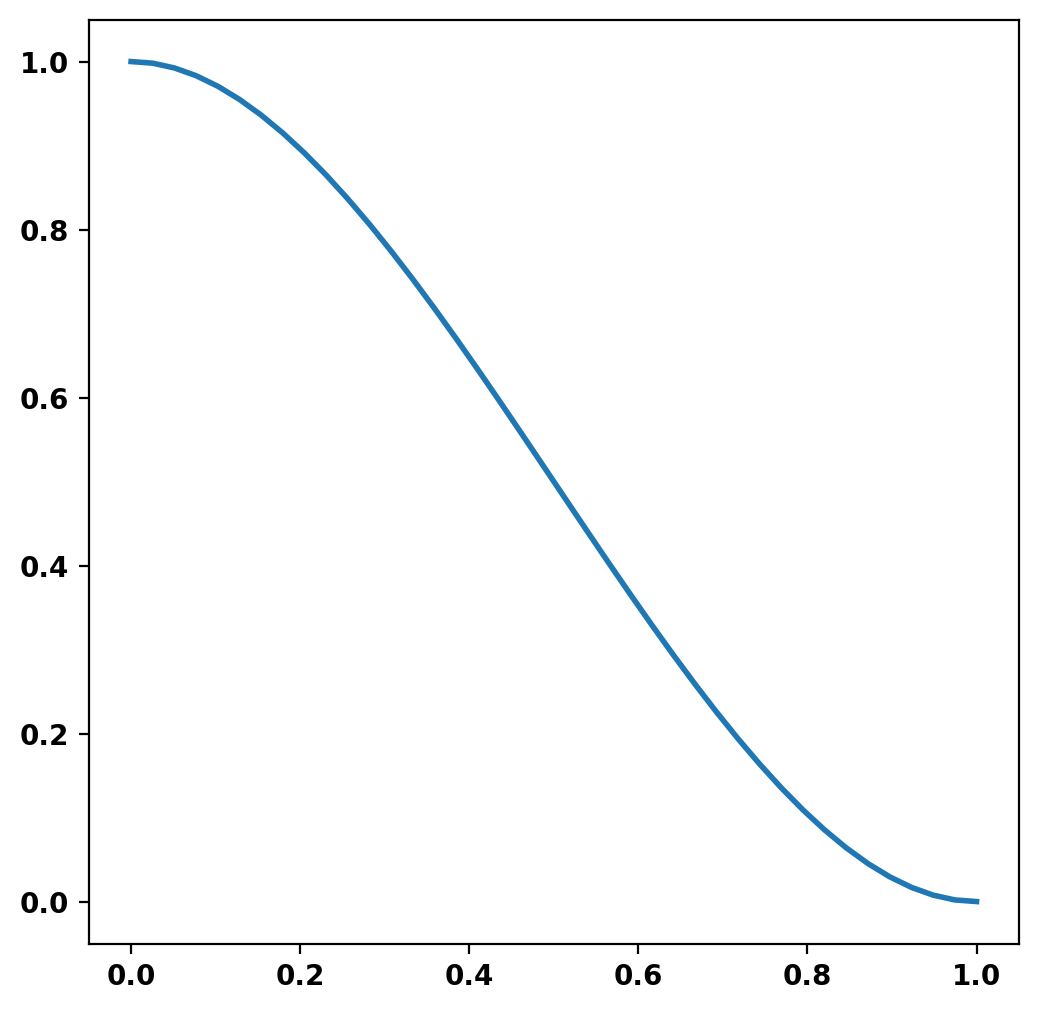
Compute initial equilibrium
We can now compute a free-boundary equilibrium using these constraints. Note that before running a calculation for the first time we must initialize the flux function \(\psi\), which can be done using init_psi. This subroutine initializes the flux using the specified Ip_target from above, which is evenly distributed over the entire plasma region or only with a boundary defined using a center point (R,Z), minor radius (a), and elongation and triangularity. Coil currents are also initialized at this point using the constraints above and this uniform plasma current initialization.
We plot the solution and coil currents after initialization but before the Grad-Shafranov solve for reference.
solve is then called to compute a self-consitent Grad-Shafranov equilibrium. If the result variable (err_flag) is zero then the solution has converged to the desired tolerance ( \(10^{-6}\) by default).
Starting non-linear GS solver
1 4.1858E-01 6.6300E-01 2.7602E-03 4.3541E-01 8.6918E-05 -4.1733E-01
2 4.8533E-01 7.5420E-01 1.0732E-03 4.3544E-01 8.2293E-05 -2.9882E-01
3 5.1712E-01 7.9707E-01 4.4141E-04 4.3567E-01 7.6874E-05 -2.9624E-01
4 5.3378E-01 8.1932E-01 2.0386E-04 4.3589E-01 7.3108E-05 -2.8162E-01
5 5.4279E-01 8.3126E-01 1.0251E-04 4.3604E-01 7.1115E-05 -2.6197E-01
6 5.4772E-01 8.3776E-01 5.4047E-05 4.3613E-01 7.0010E-05 -2.4857E-01
7 5.5044E-01 8.4132E-01 2.9203E-05 4.3619E-01 6.9297E-05 -2.4431E-01
8 5.5194E-01 8.4328E-01 1.5971E-05 4.3623E-01 6.8838E-05 -2.4409E-01
9 5.5277E-01 8.4437E-01 8.7860E-06 4.3625E-01 6.8557E-05 -2.4332E-01
10 5.5323E-01 8.4496E-01 4.8495E-06 4.3626E-01 6.8391E-05 -2.4281E-01
11 5.5348E-01 8.4530E-01 2.6817E-06 4.3627E-01 6.8296E-05 -2.4248E-01
12 5.5363E-01 8.4548E-01 1.4846E-06 4.3627E-01 6.8240E-05 -2.4218E-01
13 5.5371E-01 8.4558E-01 8.2246E-07 4.3627E-01 6.8207E-05 -2.4195E-01
Timing: 8.3265999972354621E-002
Source: 3.4822000132407993E-002
Solve: 2.2271999972872436E-002
Boundary: 2.1390000474639237E-003
Other: 2.4032999819610268E-002
Plot equilibrium
Flux surfaces of the computed equilibrium can be plotted using the plot_psi() method. The additional plotting methods plot_machine() and plot_constraints() are also used to show context and other information. Each method has a large number of optional arguments for formatting and other options. We also use plot_eddy() to show the eddy currents in the vessel due to the change in flux from the preceding equilibrium.
Basic parameters can be displayed using the print_info() method. For access to these quantities as variables instead the get_stats() can be used.
The final coil currents can also be retrieved using the get_coil_currents() method, which are all within the approximate coil limits imposed above.
Equilibrium Statistics: Topology = Limited Toroidal Current [A] = 7.9994E+04 Current Centroid [m] = 0.407 0.000 Magnetic Axis [m] = 0.436 0.000 Elongation = 1.537 (U: 1.537, L: 1.537) Triangularity = 0.130 (U: 0.129, L: 0.131) Plasma Volume [m^3] = 0.643 q_0, q_95 = 1.266 6.309 Plasma Pressure [Pa] = Axis: 1.7620E+03, Peak: 1.7620E+03 Stored Energy [J] = 3.7342E+02 <Beta_pol> [%] = 34.6606 <Beta_tor> [%] = 1.3011 <Beta_n> [%] = 1.0473 Diamagnetic flux [Wb] = 8.6550E-04 Toroidal flux [Wb] = 8.3542E-02 l_i = 1.1889 Coil Currents [kA]: REDU: 0.70 ( 5.00) [ 13.94%] REDL: 0.70 ( 5.00) [ 13.94%] ORANGEU: 0.09 ( 10.00) [ 0.93%] ORANGEL: 0.09 ( 10.00) [ 0.93%] YELLOWU: -0.00 ( -50.00) [ 0.00%] YELLOWL: -0.00 ( -50.00) [ 0.00%] GREENU: 0.43 ( 2.00) [ 21.49%] GREENL: 0.43 ( 2.00) [ 21.49%] BLUEU: -4.22 ( -10.00) [ 42.17%] BLUEL: -4.22 ( -10.00) [ 42.17%] INTERNALU: 2.00 ( 10.00) [ 19.99%] INTERNALL: 2.00 ( 10.00) [ 20.00%] OH: 0.00 ( 20.00) [ 0.02%]
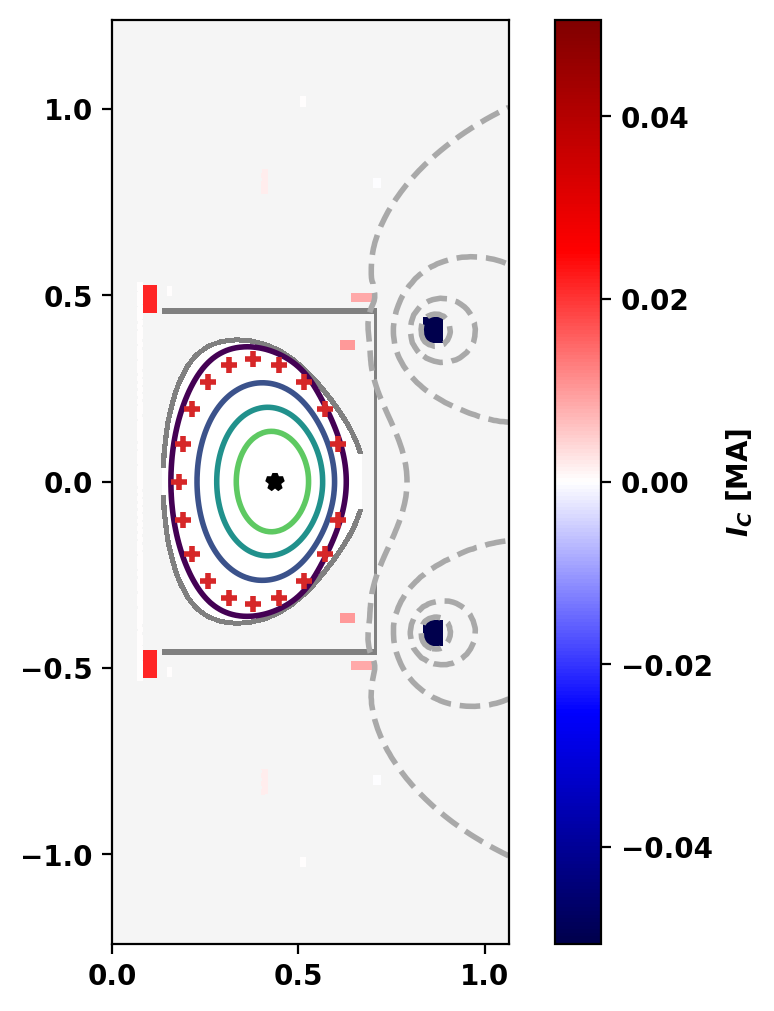
Compute equilibrium 5 ms later
Starting non-linear GS solver
1 6.2297E-01 9.5134E-01 4.1997E-04 4.3736E-01 5.7378E-05 -2.7201E-01
2 6.3261E-01 9.5593E-01 2.0964E-04 4.3754E-01 5.5415E-05 -3.0402E-01
3 6.3255E-01 9.5654E-01 7.5082E-05 4.3733E-01 5.7456E-05 -2.9697E-01
4 6.2977E-01 9.5518E-01 3.6082E-05 4.3703E-01 6.0377E-05 -2.7628E-01
5 6.2682E-01 9.5329E-01 3.1462E-05 4.3678E-01 6.2947E-05 -2.6750E-01
6 6.2456E-01 9.5163E-01 2.5292E-05 4.3660E-01 6.4777E-05 -2.6652E-01
7 6.2306E-01 9.5042E-01 1.7683E-05 4.3649E-01 6.5944E-05 -2.6756E-01
8 6.2215E-01 9.4964E-01 1.1181E-05 4.3643E-01 6.6620E-05 -2.6859E-01
9 6.2165E-01 9.4916E-01 6.5567E-06 4.3639E-01 6.6980E-05 -2.6950E-01
10 6.2138E-01 9.4889E-01 3.6173E-06 4.3638E-01 6.7157E-05 -2.7017E-01
11 6.2125E-01 9.4874E-01 1.8940E-06 4.3637E-01 6.7238E-05 -2.7058E-01
12 6.2119E-01 9.4867E-01 9.4699E-07 4.3637E-01 6.7271E-05 -2.7081E-01
Timing: 0.15450499998405576
Source: 3.2104999991133809E-002
Solve: 1.9957999989856035E-002
Boundary: 2.2590000298805535E-003
Other: 0.10018299997318536
Plot equilibrium
We now show the updated equilibrium, this time using plot_eddy() to show the eddy currents in the vessel due to the change in flux from the preceding equilibrium.
Starting CG solver
0 0.000000E+00 0.000000E+00 2.570366E-02
1 -2.919869E+00 2.672399E+02 9.998829E-03 3.741518E-05
2 -3.393750E+00 3.019796E+02 4.391137E-03 1.454117E-05
3 -3.454844E+00 3.104265E+02 1.630672E-03 5.253004E-06
4 -3.463806E+00 3.107788E+02 6.490879E-04 2.088585E-06
5 -3.465284E+00 3.100384E+02 2.386736E-04 7.698197E-07
6 -3.465484E+00 3.094506E+02 8.786765E-05 2.839473E-07
7 -3.465516E+00 3.093363E+02 3.700683E-05 1.196330E-07
8 -3.465520E+00 3.093555E+02 1.637065E-05 5.291856E-08
9 -3.465521E+00 3.093739E+02 6.449134E-06 2.084576E-08
10 -3.465521E+00 3.093818E+02 2.274598E-06 7.352074E-09
20 -3.465521E+00 3.093829E+02 1.742395E-10 5.631839E-13
Equilibrium Statistics:
Topology = Limited
Toroidal Current [A] = 9.0004E+04
Current Centroid [m] = 0.407 0.000
Magnetic Axis [m] = 0.436 0.000
Elongation = 1.538 (U: 1.538, L: 1.538)
Triangularity = 0.133 (U: 0.135, L: 0.132)
Plasma Volume [m^3] = 0.644
q_0, q_95 = 1.143 5.644
Plasma Pressure [Pa] = Axis: 2.2242E+03, Peak: 2.2242E+03
Stored Energy [J] = 4.7273E+02
<Beta_pol> [%] = 34.7576
<Beta_tor> [%] = 1.6411
<Beta_n> [%] = 1.1767
Diamagnetic flux [Wb] = 1.0908E-03
Toroidal flux [Wb] = 8.4048E-02
l_i = 1.1911
Coil Currents [kA]:
REDU: 0.74 ( 5.00) [ 14.74%]
REDL: 0.74 ( 5.00) [ 14.74%]
ORANGEU: 0.14 ( 10.00) [ 1.38%]
ORANGEL: 0.14 ( 10.00) [ 1.38%]
YELLOWU: -0.00 ( -50.00) [ 0.00%]
YELLOWL: -0.00 ( -50.00) [ 0.00%]
GREENU: 0.50 ( 2.00) [ 25.02%]
GREENL: 0.50 ( 2.00) [ 25.02%]
BLUEU: -4.83 ( -10.00) [ 48.30%]
BLUEL: -4.83 ( -10.00) [ 48.30%]
INTERNALU: 2.16 ( 10.00) [ 21.58%]
INTERNALL: 2.16 ( 10.00) [ 21.59%]
OH: 0.00 ( 20.00) [ 0.01%]
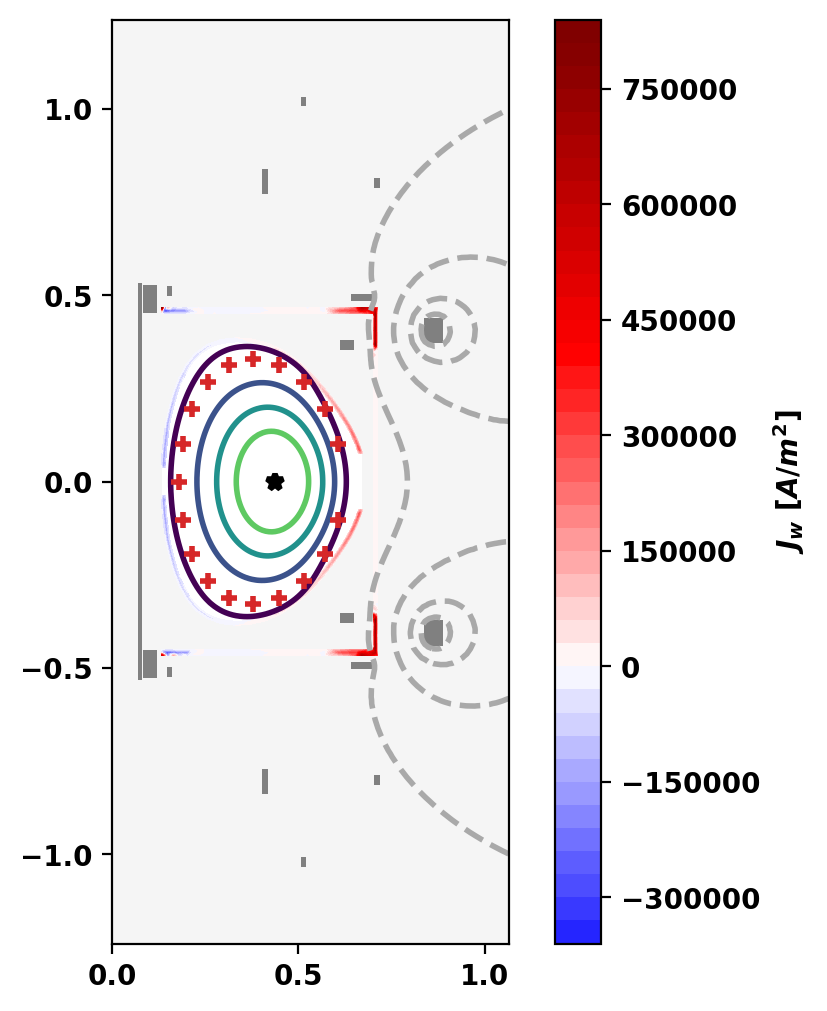
Linear Stability Analysis
We can compute the most unstable eigenmodes of the linearized system along with their eigenvalues, or growth rates, using the eig_td() method. In this case, the most unstable mode corresponds to vertical instability, and has a growth rate of ~480 s^-1.
We also plot the vertically unstable mode and the eddy currents in conducting structures using the plot_eddy() method.
Growth rate = -481.12 [1/s]
